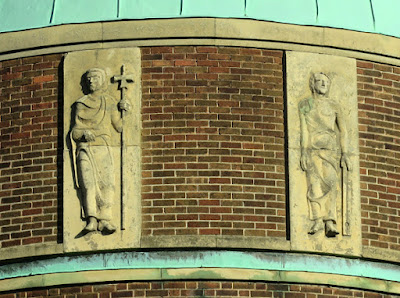 |
| Relief sculptures at St. Theresa's church |
During my exploration of the Carr Brook, shortly after I had set off downstream towards Hastilar Road South, I caught a glimpse of the Catholic church of St. Theresa of the Child Jesus in Manor, which I very often drove past when driving from High Green to work in Chesterfield.
Set next to the Prince of Wales Road, part of the south Sheffield ring road, it forms a very prominent landmark and, when searching for post-architectural sculptures to photograph for the RCHME, this is one of the first places that I visited.
Completed in 1960 with a modern Byzantine design by John Rochford and Partners, the church is built with a brick clad reinforced concrete frame, with artificial stone used for various dressings; however, from afar, its most noticeable feature is the copper roof to its dome.
Moving closer, I was particularly interested in the low-relief figurative sculptures beneath the dome, which depict the twelve Apostles. According to Taking Stock, they were carved by Alan Rochford, the brother of the architect, and his wife Sylvia - both lecturers at Nuneaton College of Art.
Walking up to Prince of Wales Road, I took a few photographs of these using the zoom lens on my Canon G16, but I couldn’t see any distinguishing physical features that give me an idea of the potential provenance – if they are actually stone.
Looking closely at my photos, I think it is quite possible that they are cast in artificial stone. They are all very uniform in colour and texture and a couple of the relief sculptures are crumbling into pieces, in a fashion that I don’t recall seeing in a building stone.
Moving around to its north end, which was in deep shade, I just took a couple of photos to record the general structure and architectural elements on this elevation, which includes an artificial stone clad round tower.
With no light shining on its surface, I didn’t examine this cladding material with a hand lens or apply a hydrochloric acid test but, when getting close to the walling, the coarse particles of the aggregate can be clearly seen and the lack of sedimentary structures becomes apparent.
Before retracing my steps back to the Carr Brook, to continue investigating its course down to Bowden Housteads Wood, I took a good look at the statue of St Theresa, which is carved in what looks like Lincolnshire Limestone – possibly from Clipsham. It was made by Philip Lindsey Clark, who also carved the tympanum at the Church of the Sacred Heart in Hillsborough.









No comments:
Post a Comment